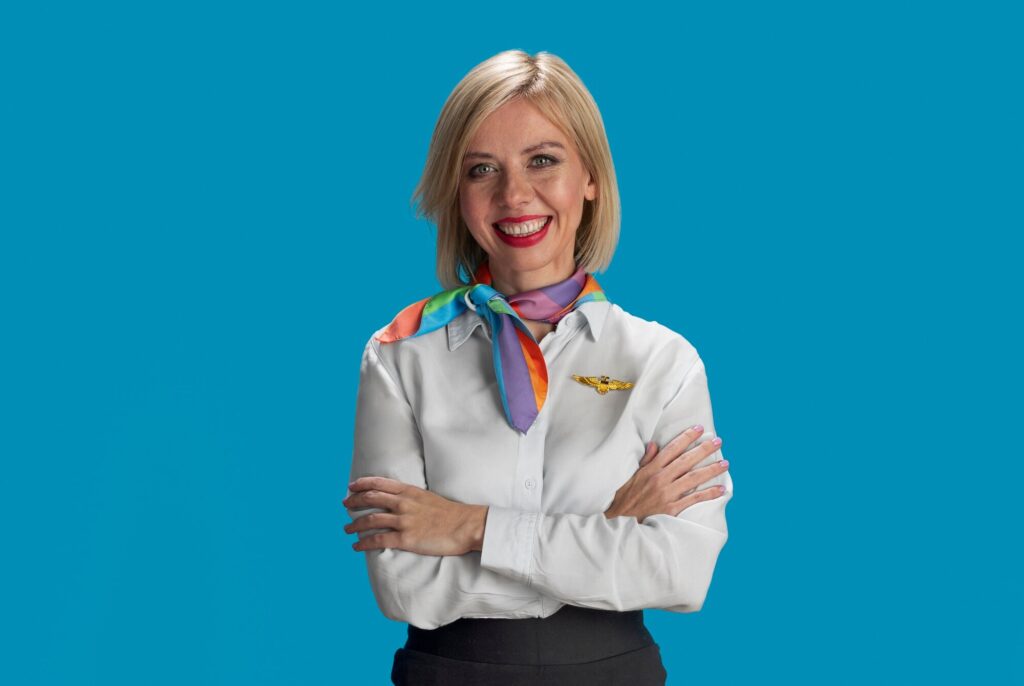Flight attendants’ responsibilities in the aviation industry go well beyond providing drinks and making sure passengers are comfortable.
They are qualified experts in charge of making sure that everyone on board is safe and healthy.
Among the numerous processes and rules they follow, one seemingly odd habit sticks out: the bracing position the cabin crew adopts during takeoff and landing.
The Bracing Position Explained by a flight attendant

Passengers frequently become curious and speculate when they see flight attendants sitting on their hands and strapping up in their jump seats during landings. But in a widely shared TikTok video, Cebu Pacific flight attendant Henny Lim clarifies. This seemingly odd position has a purpose.

According to Lim, the bracing position entails a number of particular movements. securing seatbelts, sitting up straight, resting hands on thighs with thumbs tucked in, and maintaining a loose arm position. Finally, make sure your feet are flat on the ground.
Purpose of the Bracing Position

Reducing body movement in the event of an emergency is the main goal of the bracing position. lowering the possibility of harm upon hit. Flight attendants are better equipped to endure the forces involved in a crash landing by adopting a stiff stance and fastening themselves in their seats.
Flight attendants participate in what Lim refers to as a “silent review” during this time. By becoming acquainted with emergency equipment, door operations, orders, and visual clues outside the aircraft, they mentally prepare for emergency situations.

Insights from Regulatory Authorities
Regulatory agencies such as the Federal Aviation Administration (FAA) emphasize the significance of the bracing posture. Reducing flapping and minimizing secondary impact are the two main goals of the bracing posture, per an FAA memo. In a collision, flailing or uncontrollably moving limbs might result in more injuries.
The bracing position is one way that occupants might lessen this risk. Additionally, the severity of secondary impact injuries can be lessened by putting the body—especially the head—against the surface it would hit on impact.
Flight Attendants’ Perspectives on Safety
Henny Lim’s observations regarding the bracing position are part of a larger trend in which flight attendants share their experiences and instruct passengers on safety procedures via social media sites like TikTok.
For example, Destanie, a flight attendant, has drawn attention to the outrageous stunts people engage in to try to secure a better seat. These stories may amuse viewers, but they also emphasize how crucial it is to follow safety procedures and show consideration for flight attendants’ professionalism.
Challenges and Rewards of the Profession
Destanie and Esther Sturrus, two flight attendants, offer their perspectives on the difficulties and benefits of their line of work. They are thankful for the lifestyle and opportunity their employment provides, even if they acknowledge the challenges, such as handling challenging passengers and working in high-pressure situations. Their commitment to guaranteeing passenger safety is constant in spite of the difficulties.
Flight attendants’ bracing position during takeoff and landing is more than just a custom. It’s an essential safety precaution meant to reduce the possibility of harm in an emergency. Passengers learn more about the reasoning behind this procedure and the careful planning that goes into guaranteeing their safety thanks to the opinions of experts like Henny Lim.
Passengers are empowered to approach air travel with a deeper awareness and appreciation for the commitment of those entrusted with their safety as long as flight attendants continue to share their knowledge and experiences.



